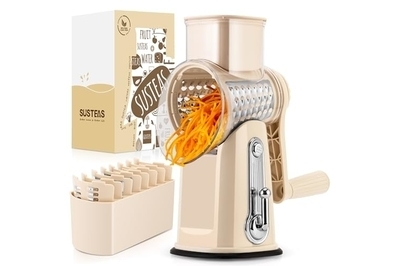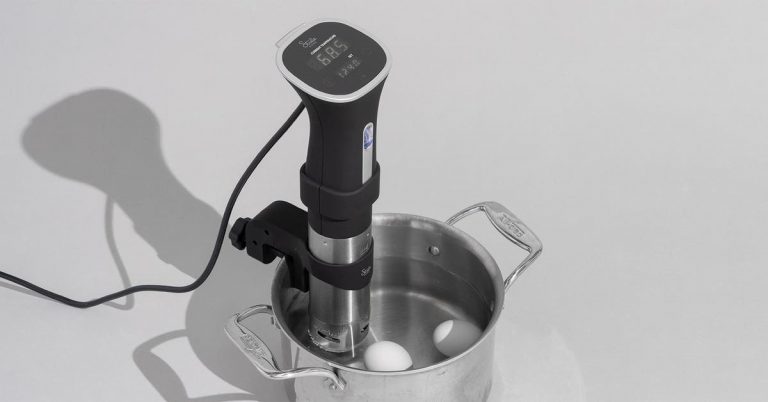The 4 Best Graters of 2025

Best for…
If you don’t want your fingers close to a grater, or you want to crank through a lot of food quickly, the Susteas Rotary Cheese Grater keeps hands safely out of the way while making quick work of shredding cheese, root vegetables, and less-typical suspects, like cookies for pie crusts.
It’s an efficient shredder. A rotary grater operates similarly to a food processor: You feed ingredients through a chute into spinning blades. But in this case, you’re turning them manually with a hand crank. With this mechanism, the Susteas grater can really blitz through root vegetables.
The potatoes we passed through the 4 mm blade (the smaller of the two shredding blades) came out resembling canned shoestring fries: long, thin, and even. And we thought the potato shreds from the 2 mm julienne blades would make killer hash browns or latkes.
While the Susteas grater can shred uniformly, it doesn’t achieve the level of delicacy of the Cuisipro 4 Sided Box Grater, which shredded potatoes to the point of translucency. But for some people, that tradeoff might be okay.
It’s good for cheese. The largest holes on the Susteas grater produce wonderful, long shreds of cheddar. My first thought was that it looked like the cheese you get on the side when you order fajitas at a Tex-Mex place.
The 2 mm julienne blades worked well on harder cheeses, like Parmesan, making thin matchsticks similar to what you might find in a container of pre-shredded parm at the grocery store. They’re too thick to easily melt into a sauce (for snow drifts of cheese, you’d be better off with our pick from Microplane), but it would still top pasta nicely.
We don’t recommend trying the 2 mm or 4 mm blades for softer cheeses (like mild cheddar) which for us resulted in an extruded mass instead of grated shreds.
It grates a larger variety of foods than a box grater. The most interesting aspect of the Susteas grater is how it does with foods you wouldn’t normally grate.
We processed walnuts into small pieces fit for cookies, and graham crackers and Oreos into crumbs like you might use in pie crusts. (In fact, in a happy coincidence, we had all of the ingredients in the test kitchen to make a chocolate cream pie with our cookie crumbs.) We even shaved frozen cubes of fruit punch into a faux snow cone.
It stays put. A rotary grater attaches to the counter using suction or a clamp. While the other rotary models we tested jiggled or came loose, the suction base of the Susteas grater stuck with a vengeance, even when we were deliberately knocking it to see if it would budge.
It’s more streamlined than other rotary graters. Other rotary graters we tested came with several interchangeable drums with different grating surfaces. The Susteas grater has a single drum frame and five sets of panels that snap into place: a slicer, a wavy slicer, a 2 mm julienne blade, 4 mm and 6 mm grating blades, and a container to keep them corralled. This feature makes this grater much less of an investment of precious kitchen space.
The panels can be fussy. The panels are simple enough to swap out, if a little finnicky. Though they snap in easily, the bottom has to be slotted in just right for the top to click into place.
Some settings are misleading. Susteas describes the 2 mm panels as the “julienne” size, which is questionable. The shreds from these holes are squared off, and the width of a matchstick. But the shreds come out curved, whereas a proper julienne is a thin, straight matchstick. If you’re looking for precision, you may be better off with a sharp knife.

If you don’t have a dishwasher, the Susteas grater can be tough to clean. All of the pieces that come into contact with food are top-rack dishwasher-safe. But if you’re hand-washing, the panels can be slippery when lathered up, and you need to clean them separately from the frame to get into all the nooks and crannies. (A bottle brush helps.)
It leaves behind treats. Depending on what’s being grated, leftover potato skins, carrot chunks, and hunks of cheese can remain between the drum itself and the drum housing. We didn’t mind this too much because it’s the case with all the rotary graters we tested, and on a box grater you’re also left with bits too small to grate. We just called them chef snacks.
Although the crank action is easy, setup is not the most accessible. One of our paid testers with limited hand dexterity found that turning the crank on the Susteas grater was easier than using a box grater, but the assembly of the drum and setup were hard.
The lever that sticks the grater to the counter was too small and stiff, the panels were difficult to grip for removal or replacement, and securing the drum in place was tough on their hands. However, they said if someone could do all of that for them, they would much prefer turning the crank over using a box grater.







